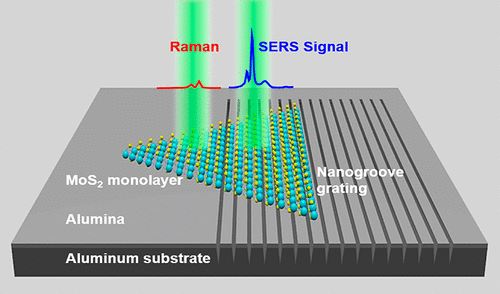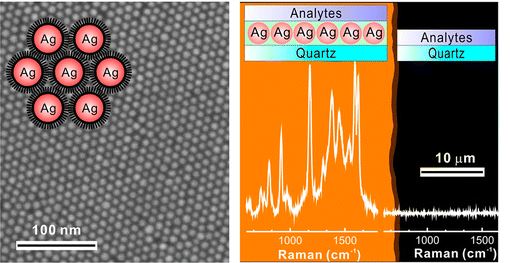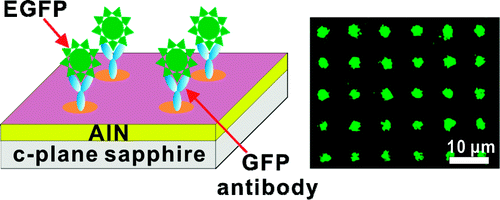Nanosensing
Epitaxial Aluminum Surface-Enhanced Raman Spectroscopy Substrates for Large-Scale 2D Material Characterization
ACS Nano 14, 8838–8845 (2020)
Soniya S. Raja, Chang-Wei Cheng, Yungang Sang, Chun-An Chen, Xin-Quan Zhang, Abhishek Dubey, Ta-Jen Yen, Yu-Ming Chang, Yi-Hsien Lee, and Shangjr Gwo*

Surface-enhanced Raman spectroscopy (SERS) is an ultrasensitive technique to identify vibrational fingerprints of trace analytes. However, present SERS techniques suffer from the lack of uniform, reproducible, and stable substrates to control the plasmonic hotspots in a wide spectral range. Here, we report the promising application of epitaxial aluminum films as a scalable plasmonic platform for SERS applications. To assess the uniformity of aluminum substrates, atomically thin transition metal dichalcogenide monolayers are used as the benchmark analyte due to their inherent two-dimensional homogeneity. Besides the distinctive spectral capability of aluminum in the ultraviolet (325 nm), we demonstrate that the aluminum substrates can even perform comparably with the silver counterparts made from single-crystalline colloidal silver crystals using the same SERS substrate design in the visible range (532 nm). This is unexpected from the prediction solely based on optical dielectric functions and illustrate the superior surface and interface properties of epitaxial aluminum SERS substrates.
Large-scale hot spot engineering for quantitative SERS at the single-molecule scale
J. Am. Chem. Soc. 137, 13698–13705 (2015)
Hung-Ying Chen, Meng-Hsien Lin, Chun-Yuan Wang, Yu-Ming Chang, Shangjr Gwo

Quantitative surface enhanced Raman spectroscopy (SERS) requires precise control of Raman enhancement factor and detection uniformity across the SERS substrate. Here, we show that alkanethiolate ligand-regulated silver (Ag) nanoparticle films can be used to achieve quantitative SERS measurements down to the single-molecule level. The two-dimensional hexagonal close-packed superlattices of Ag nanoparticles formed in these films allow for SERS detection over a large area with excellent uniformity and high Raman enhancement factor. In particular, the SERS signal from the thiolate ligands on Ag nanoparticle surfaces can be utilized as a stable internal calibration standard for reproducible quantitative measurements. We demonstrate the capability of quantitative SERS by measuring the areal densities of crystal violet molecules embedded in an ultrathin spin-on-glass detection “hot zone”, which is a planar and uniformly enhanced region several nanometers above the Ag nanoparticles. The Raman measurement results exhibit a linear response over a wide dynamic range of analyte concentration.
Ultrasensitive Surface Acoustic Wave Detection of Collective Plasmonic Heating by Close-Packed Colloidal Gold Nanoparticles Arrays
J. Phys. Chem. C, 2013, 117 (6), pp 2442–2448
Chi-Shun Chiu , Hung-Ying Chen , Chun-Fang Hsiao , Meng-Hsien Lin , and Shangjr Gwo *

A novel electrical detection method based on surface acoustic wave (SAW) is introduced to investigate the heat generation from a two-dimensional (2D) or three-dimensional (3D) close-packed gold nanoparticle (AuNP) array exhibiting tunable collective surface plasmon resonance (CSPR). We have found that the SAW sensor can detect the CSPR-induced photothermal heating effect. The conversion of absorbed light around the CSPR frequency into heat and subsequent transfer from the AuNP array to the lithium niobate (LiNbO3) substrate allows a dual delay-line SAW system to dynamically measure the resonant frequency change of the SAW oscillator coated with a 2D or 3D AuNP array. The experimental findings indicate that SAW detection provides an ultrasensitive (detection limit of temperature change <1 × 10–3 °C) electrical readout scheme for measuring the collective plasmonic heating of close-packed AuNP arrays with a linear dynamic range of incident light intensity and a designable CSPR spectral response.
Site-Selective Biofunctionalization of Aluminum Nitride Surfaces Using Patterned Organosilane Self-Assembled Monolayers
Langmuir 26, pp. 2969–2974 (2010)
Chi-Shun Chiu, Hong-Mao Lee and Shangjr Gwo*

Surface biochemical functionalization of group-III nitride semiconductors has recently attracted much interest because of their biocompatibility, nontoxicity, and long-term chemical stability under demanding physiochemical conditions for chemical and biological sensing. Among Ill-nitrides, aluminum nitride (AlN) and aluminum gallium nitride (AlGaN) are particularly important because they are often used as the sensing surfaces for sensors based oil field-effect transistor or surface acoustic wave (SAW) sensor structures. To demonstrate the possibility of site-selective biofunctionalization oil AlN surfaces, we have fabricated two-dimensional antibody micropatterns oil AlN surfaces by using patterned self-assembled monolayer (SAM) templates. Patterned SAM templates are composed of two types of organosilane molecules terminated with different functional groups (amino and methyl), which were fabricated oil AlN/sapphire substrates by combining photolithography, lift-off process, and self-assembly technique. Because the patterned SAM templates have different surface properties oil the same Surface, clear imaging contrast of SAM micropatterns can be observed by field-emission scanning electron microscopy (FF-SEM) operating at a low accelerating voltage in the range of 0.5-1.5 kV. Furthermore, the contrast in surface potential of the binary SAM microstructures was confirmed by selective adsorption of negatively charged colloidal gold nanoparticles (AuNPs). The immobilization of AuNPs was limited oil the positively charged amino-terminated regions, while they were scarcely found oil the surface regions terminated by methyl groups. In this work, selective immobilization of green fluorescent protein (G FP) antibodies was demonstrated by the specific protein binding of enhanced GFP (EGFP) labeling. The observed strong fluorescent signal front antibody functionalized regions oil the SAM-patterned AlN surface indicates the retained biological activity of specific molecular recognition resulting from the antibody-EGFP interaction. The results reported here show that micropatterning of organosilane SAMs by the combination of photolithographic process and lift-off technique is a practical approach for the fabrication of reaction regions oil AlN-based bioanalytical microdevices.
|
|